Fostering a Sustainable Campus: A Successful Selective Waste Collection Initiative in a Brazilian University
Abstract
1. Introduction
2. Materials and Methods
2.1. Initial Phase of the Selective Waste Collection Project
2.2. Selective Waste Collection Procedures
- General Recyclable Waste: Clean and properly discarded paper, plastic, and metal items suitable for recycling are separated, packed, and later delivered to the Municipal “Ecoponto”, as described in Section 2.3.
- Specific Recyclable Waste: Items such as glass, electronics waste, plastic bottles, writing instruments, and bottle caps that require differentiated selective collection are redirected to designated PEV containers, as described in Section 2.2.1. Section 2.3 details the destination of these items.
- Non-Recyclable Waste: Contaminated items, improperly discarded materials, or those with no recycling potential are separated and placed in gray bins designated for non-recyclable waste. The cleaning team then gathers these materials and forwards them to the municipal waste service for disposal at licensed landfills in accordance with the official municipal waste disposal schedule.
2.2.1. Voluntary Delivery Point (PEV)
- Glass, Electronic Waste, and Plastic Bottles: Delivered to the Municipal “Ecoponto”. Glass items are reused by local artisans or sent for industrial recycling. Electronic waste, depending on its condition, may be recycled or repurposed. Plastic bottles were recently included in the PEV system to facilitate collection and recycling. These materials are transported to the “Ecoponto” by UFSC staff on the same day as the recyclable waste from common bins, typically every 50 days.
- Bottle Caps: These are stored in 5 L containers and delivered to the Association of Parents of Autistic Individuals of Southern Santa Catarina. Depending on the accumulated volume, these containers are sent approximately every four months.
- Writing Instruments: Stored in cardboard boxes (30 × 30 cm) and shipped via mail to TerraCycle as part of the Faber-Castell® Writing Instruments Recycling Program. Shipments occur approximately every four months.
2.2.2. Community Engagement and Recycling Campaigns
2.3. Destination of Recyclable Waste
- City “Ecoponto”: Located approximately 1 km from campus, the “Ecoponto” is an initiative of the Araranguá City Hall, managed by the Municipal Environmental Foundation. It acts as a link between waste generators and either independent collectors or recycling companies, ensuring appropriate environmental disposal of materials.
- Association of Parents of Autistic Individuals of Southern Santa Catarina: Located about 3 km from campus, the association is a non-profit organization that supports children with autism spectrum disorder (ASD) and their families. Collecting plastic bottle caps is a source of income to fund the organization’s activities, with the materials later sold to recycling companies.
- TerraCycle/Faber-Castell® Initiatives: The Faber-Castell® Writing Instruments Recycling Program is a free initiative promoting the responsible disposal and recycling of used writing instruments, regardless of brand. The items are processed through collection, shredding, extrusion, and pelletizing, resulting in plastic pellets used to manufacture new products such as benches, trash bins, and plant pots.
3. Results
3.1. Impact of the Selective Waste Collection Program
3.1.1. Continuous Waste Collection Project and PEV
3.1.2. Recycling Awareness Campaigns
4. Discussion
4.1. Experience, Challenges, and Progress of the Selective Waste Collection Program
4.2. Similar University-Led Waste Collection Programs
4.2.1. Overview of University Initiatives
4.2.2. Similarities and Differences
4.2.3. Contribution to the Literature
| Title | Main Wastes Evaluated | Important Information | Reference |
|---|---|---|---|
| Food waste generation in a university and the handling efficiency of a university catering facility-scale automatic collection system | Organics | The study demonstrated that adopting an automated food waste collection system in university canteens increased collection efficiency by 30%, reduced water consumption by 20%, and increased energy consumption by 4.4 times. | [36] |
| Sustainable integrated solid waste management for a university campus: A case study of the Federal University of Technology Akure (FUTA), Nigeria | Plastics, organics, paper, glass, metals, electronics, wood, leather, and ash | The study characterized the generation and composition of solid waste in FUTA, estimating an average of 952.3 kg per day, with a per capita rate of 0.046 kg per day. The analysis revealed that 81% of the waste has recycling potential, highlighting opportunities for implementing a sustainable integrated management system based on the circular economy. Most of the waste was composed of polyethylene and paper. | [34] |
| Students’ awareness and attitudinal dispositions to e-waste management practices at a Zimbabwean university | Electronics and printing cartridges | The study investigated students’ perceptions and behaviors regarding electronic waste management at a university in Zimbabwe. Although more than two-thirds of students recognized the environmental and health risks of e-waste, 63.4% still disposed of their devices with regular trash, and only 0.9% sent them for recycling. Most stated they were unaware of any national (97.2%) or institutional (94.9%) policy for managing this waste. | [33] |
| Design of a solid waste separation, valuation and recycling centre on a university campus: Case study | Organics, plastics, paper, glass, and electronics | The article presented the design of a separation, recovery, and recycling center for the Escuela Superior Politécnica del Litoral University campus, with a processing capacity of up to 297 tons of waste per year. The proposal included the technical selection of the site, architectural and structural design, and the design of 11 internal routes and one main route for efficient collection. The center will occupy 146.37 m2 and have specific collection, classification, shredding, compaction, and weighing areas. The estimated cost for implementation is USD 28,623.25. | [31] |
| E-waste recycling assessment at university campus: A strategy toward sustainability | Electronics | The article evaluated the Recyclatron program, a selective collection and recycling system for electronic waste implemented at the Universidad Autónoma de Nayarit. In four biennial editions of the program, 28,836 kg of e-waste were collected, with an exponential growth trend, with an estimated 60 tons for the next edition. The process involves five stages: collection, classification, quantification, recovery of reusable fractions, and marketing. The most valuable recyclable materials include motherboards, copper wires, and general scrap. | [28] |
| Characterization of solid wastes as a tool to implement waste management strategies in a university campus | Organic, recyclable, hazardous, and sanitary | The study assessed the generation, composition, and recycling potential of solid waste on the University of Brasília (UnB) campus. An average of 148 kg of waste was generated daily, with 92 g per person. Most of the waste (67%) was recyclable, with plastic, paper, and cardboard standing out. Organic waste represented 57% of the total generated by the university restaurant. The management of hazardous laboratory waste was carried out via the UnB RESQUI program. After the implementation of selective collection in 2016, permanent educational actions were developed with the academic community. | [27] |
| Solid waste generation, characteristics and material recovery potentials for Landmark university campus | Organics, plastics, paper, metals, wood, electronics, and glass | The study characterized the generation and composition of solid waste at Landmark University, which produces an average of 1785.4 kg per day, with a per capita rate of 0.36 kg per person per day. The most common wastes were polyethylene, organic materials, and plastic bottles. Approximately 86% of the waste has recycling potential, while 14% can be reused through incineration or composting. The article proposes an integrated management model based on the concept of “zero waste”, suggesting installing a sorting center (LUWASC), using bins by type of waste, composting, environmental education, and acquiring equipment for processing recyclables. | [37] |
| Solid waste management approach at the university through living labs and communication strategies: Case studies in Italy and Portugal | Paper, plastics, metals, glass, and organics | The article described the implementation of solid waste separation and management models in two European universities using the concept of “living labs”. In Milan, the initiative involved the complete replacement of individual bins with selective collection islands, the use of an app for monitoring and parallel actions such as the installation of drinking fountains and the distribution of reusable bottles, reducing CO2 emissions by 45% and increasing the waste separation rate from 27% to 70%. In Lisbon, the pilot project adopted a similar strategy in a single building, including composting, removal of internal bins, and communication campaigns, with an increase of up to 58% in separating recyclables. Both projects emphasized the importance of community participation, multidisciplinary planning, and effective communication as critical factors in the success of sustainable waste management in higher education institutions. | [38] |
| Design and implementation study of a permanent selective collection program (PSCP) on a university campus in Brazil | Paper, organics, plastics, and metals | The study presented the design, implementation, and evaluation of a PSCP at the Federal University of Itajubá (UNIFEI). Solid waste generation was characterized by sampling and gravimetric analysis, emphasizing paper and organic matter as the main components. The program included educational actions, collection infrastructure, diagnosis through questionnaires, and environmental simulations with the LandGEM and WARM models. With 90% recycling, avoiding the emission of up to 7 tCO2eq was possible. The project also implemented composting with food waste and prunings. The program’s initial cost was estimated at BRL 157 thousand, with monthly maintenance of BRL 3.3 thousand. | [13] |
| Environmental impact evaluation of university integrated waste management system in India using life cycle analysis | Organics, plastics, paper, cardboard, metals, glass, leather, and electronics | The study used life cycle analysis to compare different solid waste management scenarios on a university campus in India. In the current scenario, which represents uncontrolled landfill disposal, greenhouse gas emissions were 1388 kg CO2eq per tonne of waste. Adopting integrated systems with 50% and 90% source segregation reduced emissions by 50.9% and 86.5%, respectively. The most efficient scenarios included anaerobic digestion, composting, and landfilling without energy recovery, allowing for greater material recovery and lower environmental impact. | [32] |
| Low carbon solid waste collection and transportation route in university: A case study | General | The study assessed the waste collection and transportation system at Mae Fah Luang University, identifying operational flaws that increased carbon emissions. The conventional model used twelve collection points and three daily routes, resulting in 13.58 kg CO2eq daily. Two new routes were proposed: Route A, with a reduction to 6 points and two daily shifts, resulting in 1.97 kg CO2eq per day, and Route B, based on waste separation, with a total emission of 3.36 kg CO2eq per day. The routes were planned with the support of Google Earth and considered strategic location, shorter collection time, reduced overhead, and improved logistics. | [39] |
| Case study of solid waste management at a college campus | Organics, paper, plastics, glass, metals, rubber, construction, sanitary, and electronics | The study evaluated the waste management system on a university campus with approximately 8000 people. Waste was collected from various sources (accommodation, canteens, laboratories, university hospitals, and construction sites) and taken to the Recycling Centre (RC). Segregation was done at source only in the staff accommodations; in other sectors, waste was segregated at the RC, with colored bins for different types. Biodegradable waste was composted, resulting in fertilizer being used at the university. Non-biodegradable waste was segregated by plastic, paper, metal, or glass type and sold. The program generated monthly savings of approximately BRL 25,540. | [29] |
| Separate waste collection in higher education institutions with its technical and social aspects: A case study for a university campus | Paper, plastics, metals, glass, organic, and non-recyclable waste | The study assessed the technical and social aspects of selective waste collection on a university campus based on a daily weighing of waste before and after implementing the system. After separation, the waste was classified as 35% plastic/metal, 10% paper, 10% glass, 14% compostable, and 31% non-recyclable, with an estimated total recycling rate of 69%. However, the social analysis revealed low community awareness: only 16% of respondents were aware of the Zero Waste Regulation (Published in Turkey on 12 July 2019), and many separated wastes without knowing its purpose. The most conscious participation was observed among faculty members. The study concludes that the effectiveness of selective waste collection depends on adequate infrastructure, incentives, and continuous environmental education and that it is necessary to strengthen the perception of collective responsibility among campus users. | [30] |
| Optimal planning of selective waste collection | Paper, plastics, and glass | The paper presented an optimization model for selective collection on university campuses in Bucharest based on geographic information systems (GIS) and routing algorithms. The model considered the location of collection points, depots, and road networks, with the aim of minimizing total transportation time, vehicle number, and logistics costs. A pilot project between February and July 2006 collected twenty-two tons of recyclables, including twelve tons of paper, seven tons of plastic, and three tons of glass. | [35] |
| Selective collection of recyclable waste in universities of low-middle income countries: Lessons learned in Bolivia | Plastics, paper, cardboard, organics, metals, glass, and non-recyclable waste | The UMSA-recycle project introduced a selective collection system for paper and plastic at one of the largest universities in La Paz. After implementation, a significant improvement in student awareness and behavior was observed, as measured by questionnaires administered in 2018 and 2019. In one month, 15 kg of plastic and 37.1 kg of paper and cardboard were collected from the estimated potential, with greater adherence to paper separation. The project followed a five-stage methodology: diagnosis, institutional approval, stakeholder engagement, implementation, and evaluation. The work of volunteers and awareness-raising campaigns were essential to its success. Despite financial and infrastructure limitations, the model proved replicable for other universities in low- and middle-income countries, highlighting the importance of institutional engagement and coordination with municipal policies to formalize the recycling chain. | [26] |
5. Conclusions
Supplementary Materials
Author Contributions
Funding
Institutional Review Board Statement
Informed Consent Statement
Data Availability Statement
Acknowledgments
Conflicts of Interest
Abbreviations
| PEV | Voluntary Delivery Point |
| PPM | Paper, Plastics, and Metal |
| ASD | Autism Spectrum Disorder |
| SDGs | Sustainable Development Goals |
| UN | United Nations |
| SWM | Solid Waste Management |
| LCA | Lifecycle Assessments |
References
- Kaza, S.; Yao, L.C.; Bhada-Tata, P.; Van Woerden, F. What a Waste 2.0: A Global Snapshot of Solid Waste Management to 2050; World Bank Publications: Washington, DC, USA, 2018; ISBN 978-1-46481-329-0. [Google Scholar]
- UNEP United Nations Environment Programme. Global Waste Management Outlook 2024. Available online: https://www.unep.org/resources/global-waste-management-outlook-2024 (accessed on 7 May 2025).
- Barbosa, A.; Gonçalves, T.; Simoes, P. Improving Municipal Solid Waste Services: Insights into Efficiency, Productivity, and Recycling in Brazil. Sustainability 2025, 17, 2519. [Google Scholar] [CrossRef]
- Aguirre Rodríguez, E.; Hernández, C.; Rodríguez, E.; Silva, A.; Marins, F. Reverse Logistics and the Circular Economy: A Study before and after the Implementation of the National Solid Waste Policy in Brazil. Recycling 2024, 9, 64. [Google Scholar] [CrossRef]
- OECD. Waste Management and the Circular Economy in Selected OECD Countries: Evidence from Environmental Performance Reviews, OECD Environmental Performance Reviews. Available online: https://www.oecd.org/en/publications/waste-management-and-the-circular-economy-in-selected-oecd-countries_9789264309395-en.html (accessed on 7 May 2025).
- United Nations. Transforming Our World: The 2030 Agenda for Sustainable Development. Available online: https://sdgs.un.org/2030agenda (accessed on 7 May 2025).
- ABREMA. Panorama dos Resíduos Sólidos no Brasil. Associação Brasileira de Resíduos e Meio Ambiente. Available online: https://www.abrema.org.br/wp-content/uploads/dlm_uploads/2024/03/Panorama_2023_P1.pdf (accessed on 7 May 2025).
- Gherheș, V.; Dragomir, G.M.; Cernicova-Buca, M.; Palea, A. Enhancing Sustainability in University Campuses: A Study on Solid Waste Generation and Disposal Practices among Students in Politehnica University Timisoara, Romania. Sustainability 2024, 16, 6866. [Google Scholar] [CrossRef]
- Qu, D.; Shevchenko, T.; Shams Esfandabadi, Z.; Ranjbari, M. College Students’ Attitude towards Waste Separation and Recovery on Campus. Sustainability 2023, 15, 1620. [Google Scholar] [CrossRef]
- Rodríguez-Guerreiro, M.-J.; Torrijos, V.; Soto, M. A Review of Waste Management in Higher Education Institutions: The Road to Zero Waste and Sustainability. Environments 2024, 11, 293. [Google Scholar] [CrossRef]
- Leal Filho, W.; Vargas, V.R.; Salvia, A.L.; Brandli, L.L.; Pallant, E.; Klavins, M.; Ray, S.; Moggi, S.; Maruna, M.; Conticelli, E.; et al. The role of higher education institutions in sustainability initiatives at the local level. J. Clean. Prod. 2019, 233, 1004–1015. [Google Scholar] [CrossRef]
- Leal Filho, W.; Shiel, C.; Paço, A.; Mifsud, M.; Ávila, L.V.; Brandli, L.L.; Molthan-Hill, P.; Pace, P.; Azeiteiro, U.M.; Vargas, V.R. Sustainable Development Goals and sustainability teaching at universities: Falling behind or getting ahead of the pack? J. Clean. Prod. 2019, 232, 285–294. [Google Scholar] [CrossRef]
- Barros, R.; Filho, G.; Moura, J.; Pieroni, M.; Vieira, F.; Lage, L.; Samprogna Mohor, G.; Bastos, A. Design and implementation study of a Permanent Selective Collection Program (PSCP) on a University campus in Brazil. Resour. Conserv. Recycl. 2013, 80, 97–106. [Google Scholar] [CrossRef]
- Trigo, A.G.M.; da Cunha, M.; Maruyama, U.G.R.; Fragoso, L.d.C.P.L.; Cordeiro, N.M.; Lemos, W.F.; Bernardes, B.d.O. Coleta seletiva solidária: Uma experiência exitosa e sustentável no Rio de Janeiro/Selective collection solidarity: A successful experience and sustainable in Rio de Janeiro. Braz. J. Dev. 2021, 7, 49215–49227. [Google Scholar] [CrossRef]
- Bortolotto, G.D.S.; Bortolotto, T.; Sandi, C.G.; Baggio, I.M.; Fernandes, F.G.; Madruga, K.C.R. Implantação do projeto permanente de coleta seletiva solidária na Universidade Federal de Santa Catarina—Campus Araranguá. Braz. J. Dev. 2023, 9, 29449–29464. [Google Scholar] [CrossRef]
- IBGE Instituto Brasileiro de Geografia e Estatística. População no Último Censo. 2022. Available online: https://cidades.ibge.gov.br/brasil/sc/ararangua/panorama (accessed on 7 May 2025).
- Wikimedia Commons. Public Domain Work (Brazil). Map of Santa Catarina’s Araranguá City. Map Locator of Santa Catarina’s Araranguá City. Available online: https://commons.wikimedia.org/wiki/File:SantaCatarina_Municip_Ararangua.svg (accessed on 28 May 2025).
- Pescador, A.C.; Coelho, A.G.A.; Bortolotto, G.D.S.; Bortolotto, T. Guia de Orientação do Projeto de Coleta Seletiva Solidária da UFSC—Campus Araranguá, 1st ed.; Federal University of Santa Catarina: Araranguá, Brazil, 2024; Volume 1, ISBN 978-65-01-14209-8. [Google Scholar]
- El-Halwagy, E. Towards waste management in higher education institute: The case of architecture department (CIC-New Cairo). Results Eng. 2024, 23, 102672. [Google Scholar] [CrossRef]
- Geiger, J.L.; Steg, L.; van der Werff, E.; Ünal, A.B. A meta-analysis of factors related to recycling. J. Environ. Psychol. 2019, 64, 78–97. [Google Scholar] [CrossRef]
- Varotto, A.; Spagnolli, A. Psychological strategies to promote household recycling. A systematic review with meta-analysis of validated field interventions. J. Environ. Psychol. 2017, 51, 168–188. [Google Scholar] [CrossRef]
- González-Torre, P.L.; Adenso-Díaz, B. Influence of distance on the motivation and frequency of household recycling. Waste Manag. 2005, 25, 15–23. [Google Scholar] [CrossRef] [PubMed]
- Werner, C.M.; Makela, E. Motivations and behaviors that support recycling. J. Environ. Psychol. 1998, 18, 373–386. [Google Scholar] [CrossRef]
- Dupré, M.; Meineri, S. Increasing recycling through displaying feedback and social comparative feedback. J. Environ. Psychol. 2016, 48, 101–107. [Google Scholar] [CrossRef]
- Mintaș, O.S.; Marele, D.C.; Stanciu, A.S.; Osiceanu, A.G.; Osiceanu, A.S.; Pop, H.; Rusu, T. Sustainability of the Integrated Waste Management System: A Case Study of Bihor County, Romania. Sustainability 2025, 17, 2822. [Google Scholar] [CrossRef]
- Ferronato, N.; Guisbert Lizarazu, E.G.; Velasco Tudela, J.M.; Blanco Callisaya, J.K.; Preziosi, G.; Torretta, V. Selective collection of recyclable waste in Universities of low-middle income countries: Lessons learned in Bolivia. Waste Manag. 2020, 105, 198–210. [Google Scholar] [CrossRef]
- Nolasco, E.; Vieira Duraes, P.H.; Pereira Gonçalves, J.; de Oliveira, M.C.; Monteiro de Abreu, L.; Nascimento de Almeida, A. Characterization of solid wastes as a tool to implement waste management strategies in a university campus. Int. J. Sustain. High. Educ. 2021, 22, 217–236. [Google Scholar] [CrossRef]
- Saldaña-Durán, C.E.; Messina-Fernández, S.R. E-waste recycling assessment at university campus: A strategy toward sustainability. Environ. Dev. Sustain. 2021, 23, 2493–2502. [Google Scholar] [CrossRef]
- Krishna, A.; Nandanan, K.; Pradeep Kumar, S.S.; Srihari, K.S. Case study of solid waste management at a college campus. Int. J. Appl. Eng. Res. 2013, 8, 1871–1878. [Google Scholar]
- Gursoy Haksevenler, B.H.; Kavak, F.F.; Akpinar, A. Separate waste collection in higher education institutions with its technical and social aspects: A case study for a university campus. J. Clean. Prod. 2022, 367, 133022. [Google Scholar] [CrossRef]
- Merchán-Sanmartín, B.; Carrión-Mero, P.; Suárez-Zamora, S.; Aguilar-Aguilar, M.; Berrezueta, E. Design of a Solid Waste Separation, Valuation and Recycling Centre on a University Campus. Case Study. Int. J. Sustain. Dev. Plan. 2022, 17, 1067–1076. [Google Scholar] [CrossRef]
- Jaglan, A.K.; Cheela, V.R.S.; Vinaik, M.; Dubey, B. Environmental Impact Evaluation of University Integrated Waste Management System in India Using Life Cycle Analysis. Sustainability 2022, 14, 8361. [Google Scholar] [CrossRef]
- Maphosa, V. Students’ Awareness and Attitudinal Dispositions to E-Waste Management Practices at a Zimbabwean University. J. Inf. Policy 2021, 11, 562–581. [Google Scholar] [CrossRef]
- Ojuri, O.O.; Olowoselu, A.S.; Akinrele, J.; Ayodele, F.O.; Jayejeje, O.O. Sustainable integrated solid waste management for a university campus—A case study of the Federal University of Technology Akure (FUTA), Nigeria. Waste Manag. Bull. 2024, 2, 161–170. [Google Scholar] [CrossRef]
- Raicu, S.; Costescu, D.; Roşca, E.; Popa, M. Optimal planning of selective waste collection. In WIT Transactions on Ecology and the Environment; Wessex Institute: Southampton, UK, 2011; Volume 150, pp. 785–794. [Google Scholar]
- Mui, K.W.; Wong, L.T.; Tsang, T.-W.; Chiu, Y.H.; Lai, K.-W. Food waste generation in a university and the handling efficiency of a university catering facility-scale automatic collection system. Facilities 2022, 40, 297–315. [Google Scholar] [CrossRef]
- Oladejo, O.S.; Auta, A.M.; Ibikunle, P.D.; Omamofo, E.K.W.; Oladejo, O.S. Solid waste generation, characteristics and material recovery potentials for Landmark University Campus. Int. J. Civ. Eng. Technol. 2018, 9, 1071–1082. [Google Scholar]
- Di Salvatore, S.; Magatti, G.; Acciarri, M.; Rossetti, M.; da Costa, L.P.; Ribeiro, I. Solid Waste Management Approach at the University through Living Labs and Communication Strategies: Case Studies in Italy and Portugal. Sustainability 2022, 14, 5240. [Google Scholar] [CrossRef]
- Pasukphun, N. Low Carbon Solid Waste Collection and Transportation Route In University: A Case Study. J. Environ. Sci. Technol. 2015, 8, 180–187. [Google Scholar] [CrossRef][Green Version]
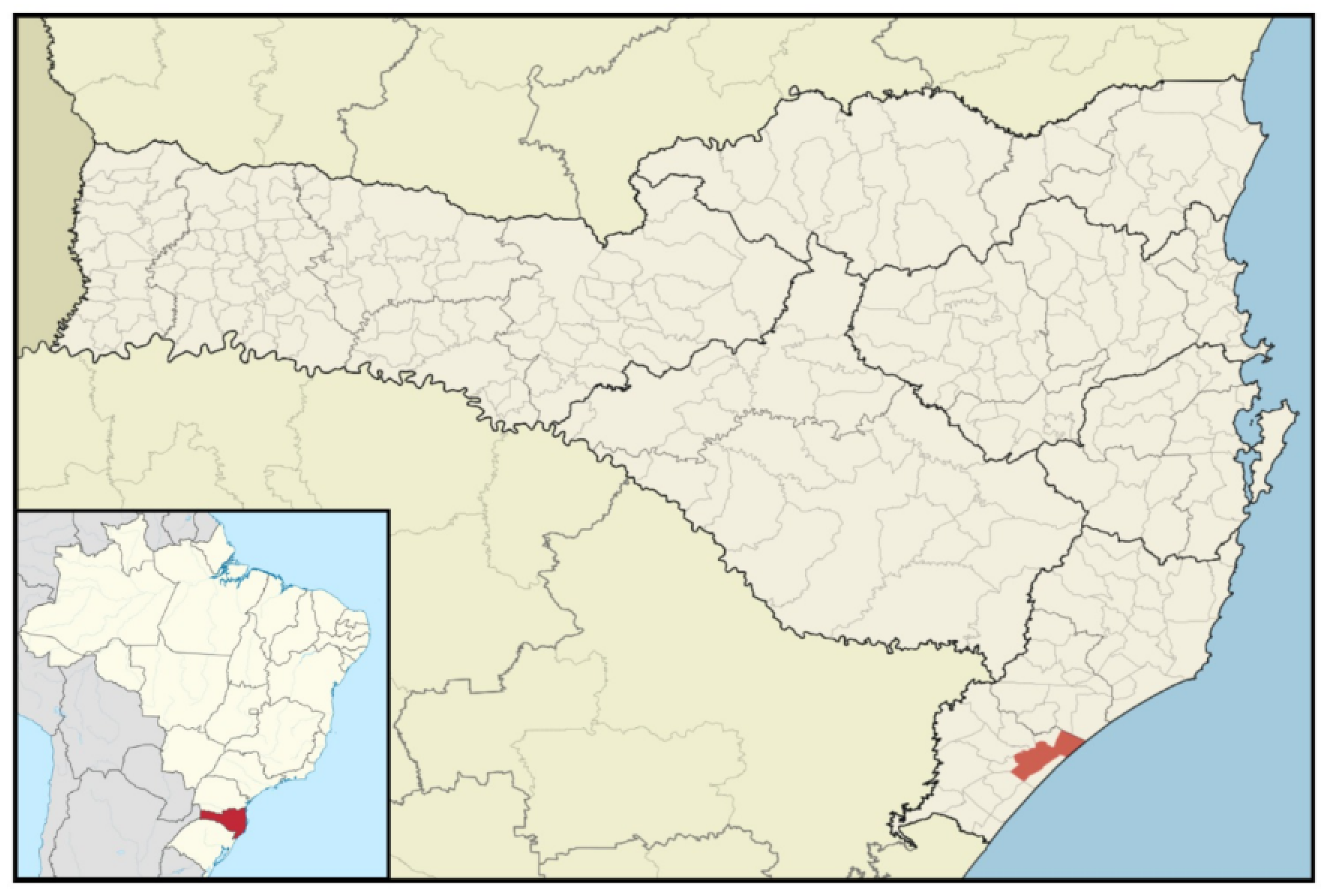
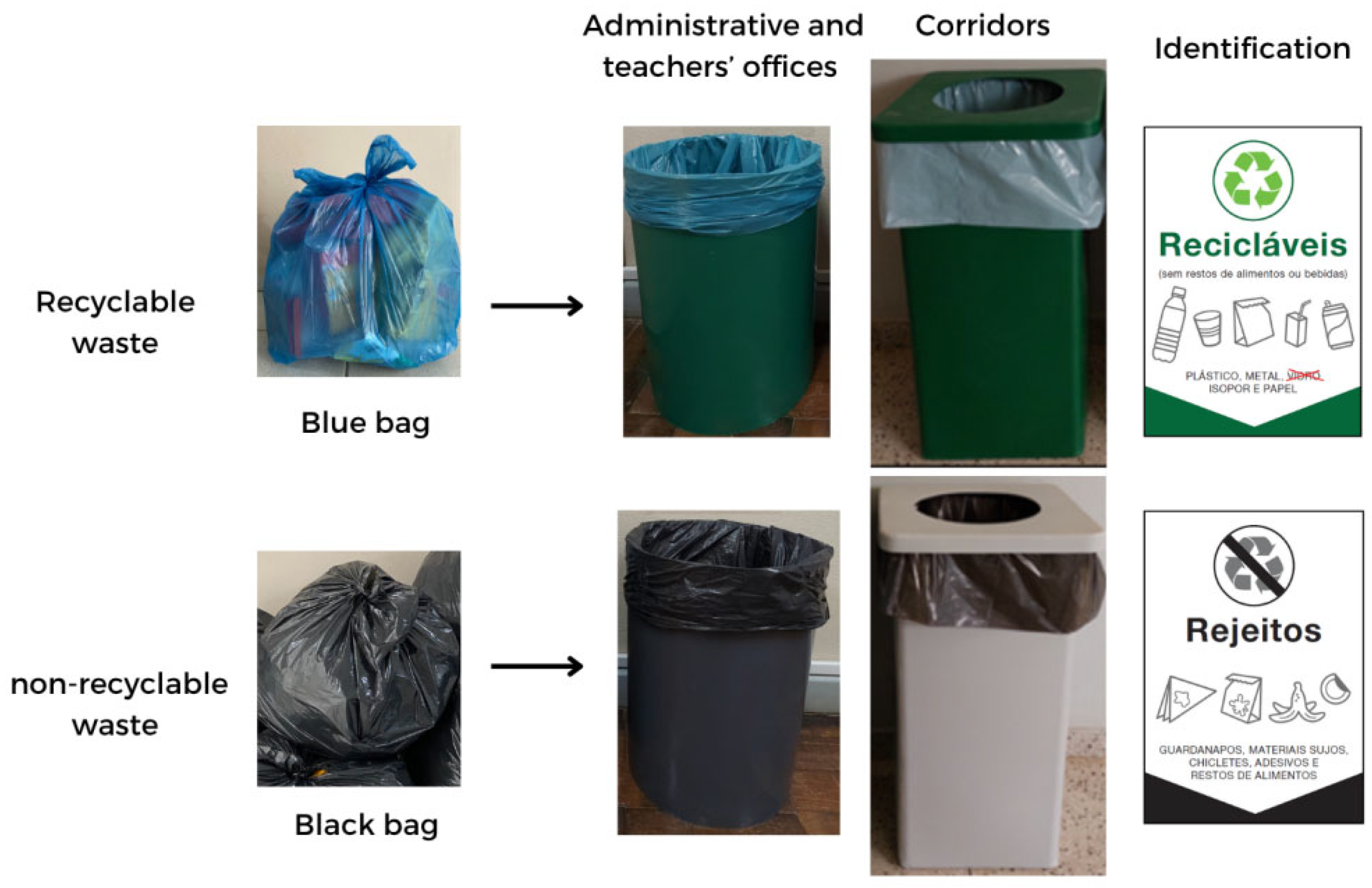
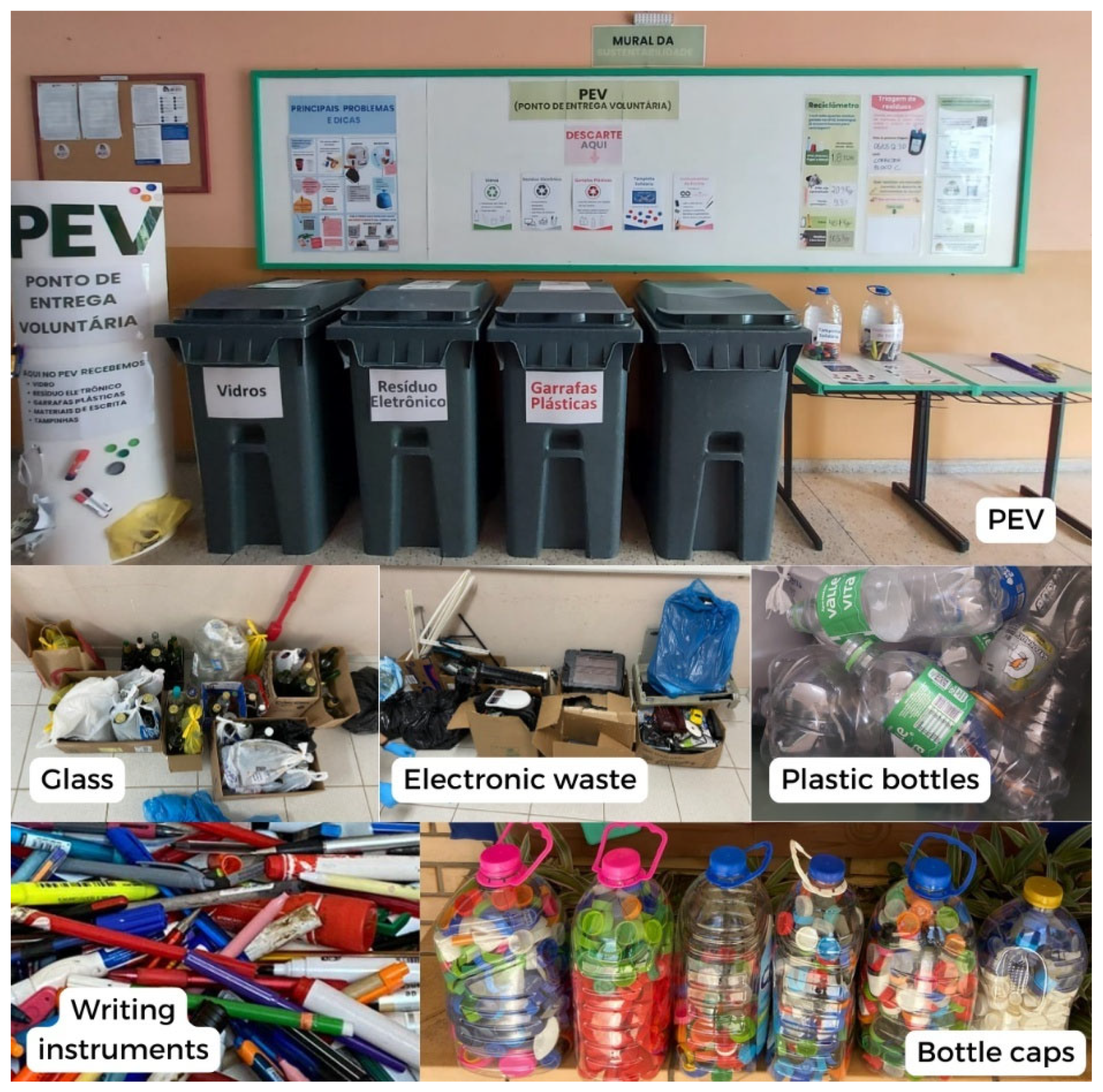
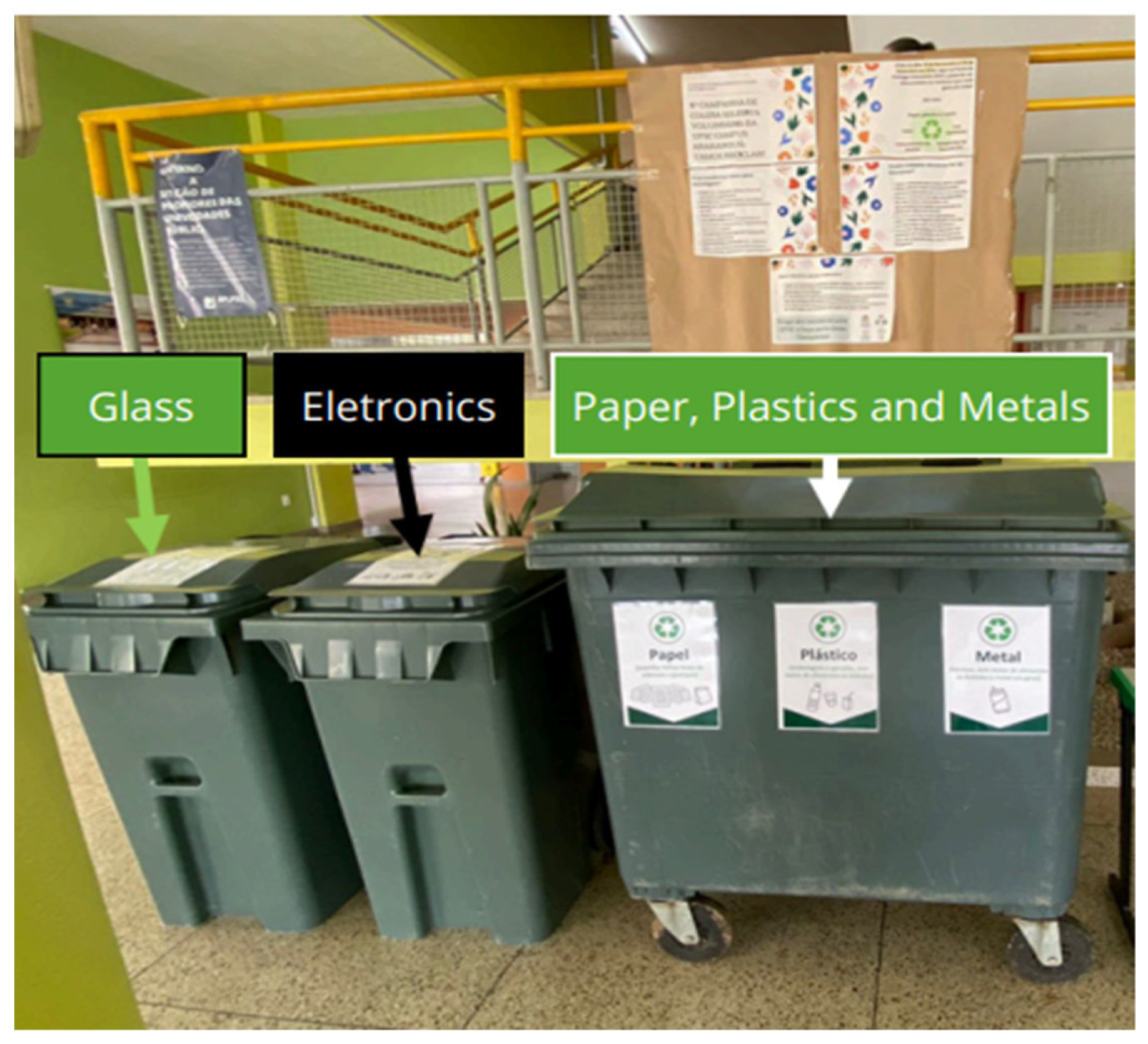
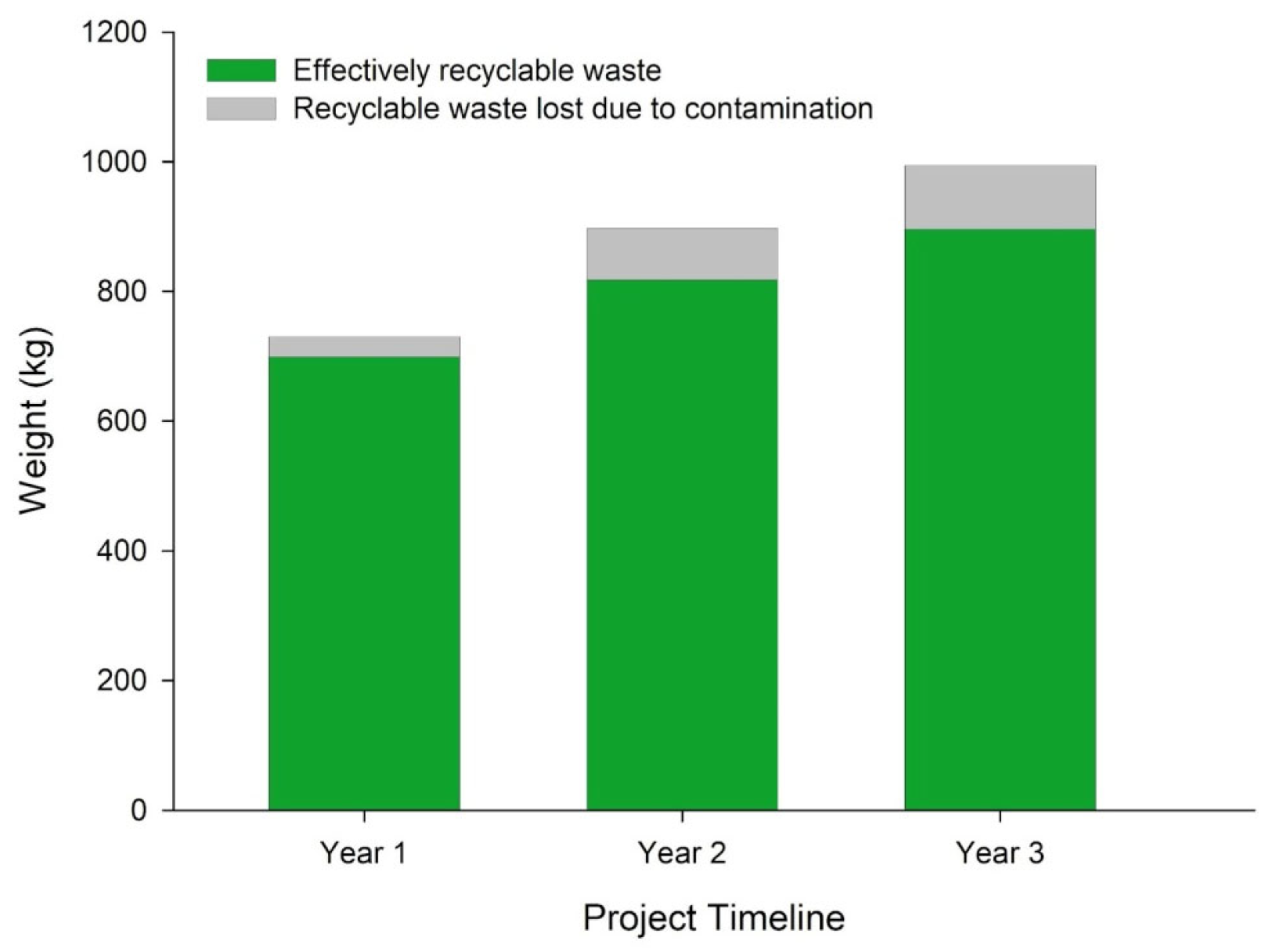
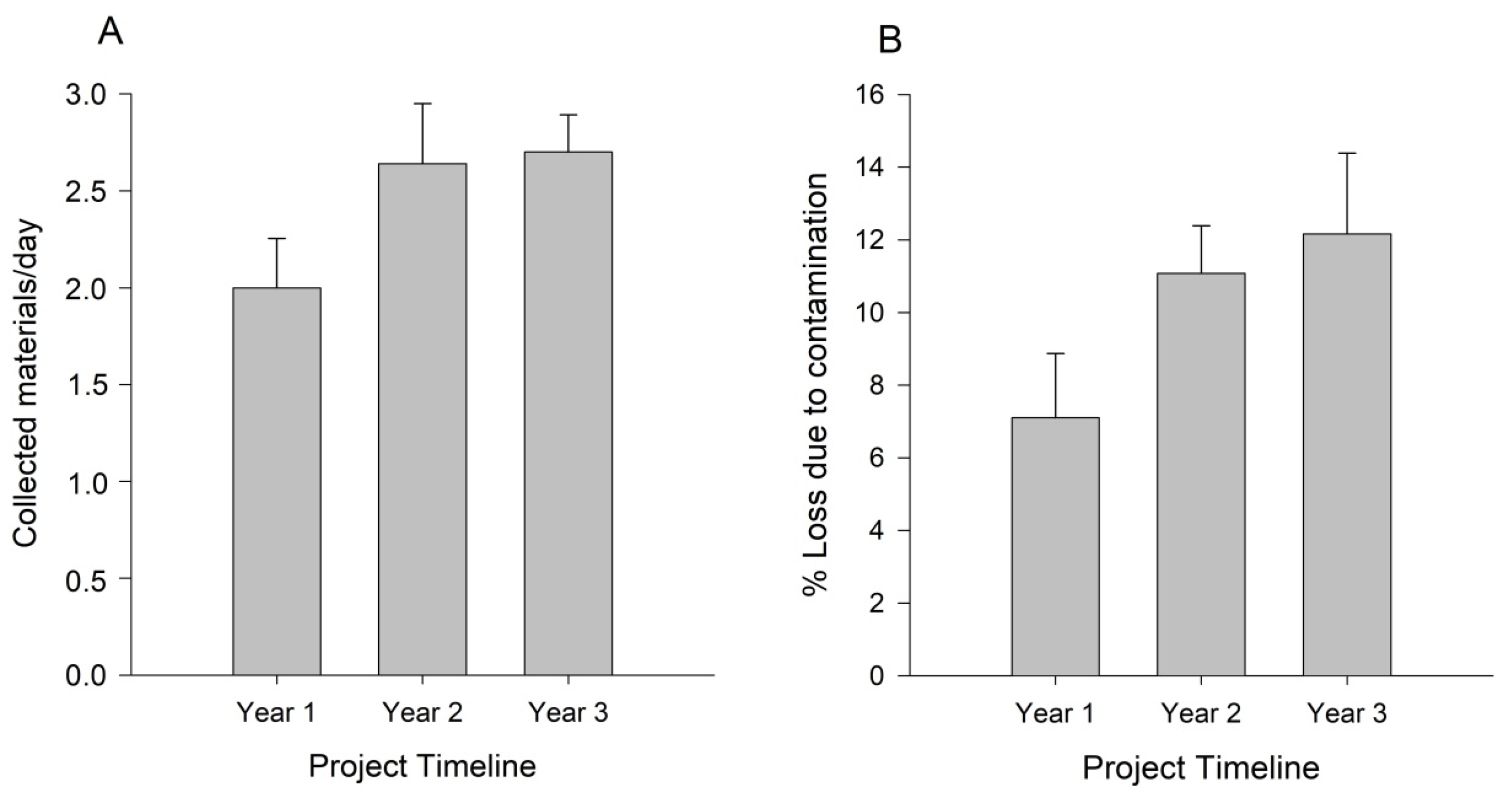

| Year 1 | Year 2 | Year 3 | Total | |
| PPM (kg) | 189.50 | 15.00 | 55.60 | 260.10 |
| PPM Lost (kg) | 0.00 | 0.00 | 4.65 | 4.65 |
| Glass (kg) | 34.50 | 25.00 | 145.45 | 204.95 |
| Electronics (kg) | 3.00 | 6.00 | 38.40 | 47.40 |
| Gathering Interval (days) | 9 | 14 | 77 | 100 |
Disclaimer/Publisher’s Note: The statements, opinions and data contained in all publications are solely those of the individual author(s) and contributor(s) and not of MDPI and/or the editor(s). MDPI and/or the editor(s) disclaim responsibility for any injury to people or property resulting from any ideas, methods, instructions or products referred to in the content. |
© 2025 by the authors. Licensee MDPI, Basel, Switzerland. This article is an open access article distributed under the terms and conditions of the Creative Commons Attribution (CC BY) license (https://creativecommons.org/licenses/by/4.0/).
Share and Cite
Savi-Bortolotto, G.D.; Pescador, A.C.; Bortolotto, T.; Sandi, C.G.; de Oliveira, A.V.; Mendes, M.R.P.; Madruga, K.C.R.; da Silva Júnior, A.H. Fostering a Sustainable Campus: A Successful Selective Waste Collection Initiative in a Brazilian University. Sustainability 2025, 17, 6377. https://doi.org/10.3390/su17146377
Savi-Bortolotto GD, Pescador AC, Bortolotto T, Sandi CG, de Oliveira AV, Mendes MRP, Madruga KCR, da Silva Júnior AH. Fostering a Sustainable Campus: A Successful Selective Waste Collection Initiative in a Brazilian University. Sustainability. 2025; 17(14):6377. https://doi.org/10.3390/su17146377
Chicago/Turabian StyleSavi-Bortolotto, Geovana Dagostim, Ana Carolina Pescador, Tiago Bortolotto, Camila Garbin Sandi, Alícia Viana de Oliveira, Matheus Rodrigues Pereira Mendes, Kátia Cilene Rodrigues Madruga, and Afonso Henrique da Silva Júnior. 2025. "Fostering a Sustainable Campus: A Successful Selective Waste Collection Initiative in a Brazilian University" Sustainability 17, no. 14: 6377. https://doi.org/10.3390/su17146377
APA StyleSavi-Bortolotto, G. D., Pescador, A. C., Bortolotto, T., Sandi, C. G., de Oliveira, A. V., Mendes, M. R. P., Madruga, K. C. R., & da Silva Júnior, A. H. (2025). Fostering a Sustainable Campus: A Successful Selective Waste Collection Initiative in a Brazilian University. Sustainability, 17(14), 6377. https://doi.org/10.3390/su17146377






